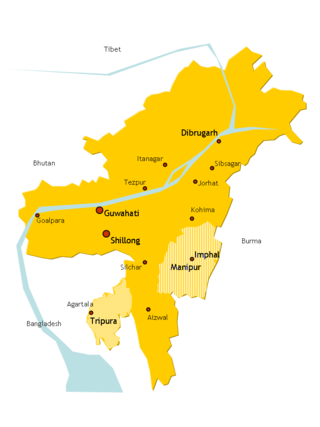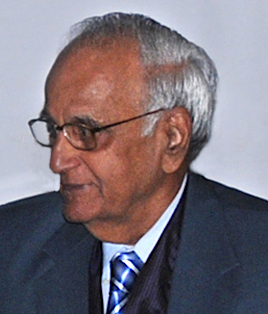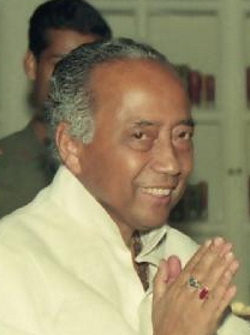
Mizoram is a landlocked state in northeast India, with Aizawl as its seat of government and largest city. Within India's northeast region, it is the southernmost state, sharing borders with three of the Seven Sister States, namely Tripura, Assam and Manipur, and also shares a 722-kilometre (449 mi) border with the neighbouring countries of Bangladesh and Myanmar. The state spans over an area of approximately 21,087 square kilometres, of which approximately 91% is forested. With an estimated population of 1.25 million in 2023, it is the second least populous state in the country.
Mizo Union was the first political party in Mizoram, northeast India. It was founded on 6 April 1946 at Aizawl as the Mizo Common People's Union. At the time of independence of India from the british rule in india in 1947, the party was the only political force in the Lushai Hills. It won the first Mizoram District Council general election under the new Indian Union in 1951, and consecutively in 1957, 1962 and 1966.
The Mizo National Front is a regional political party in Mizoram, India. MNF emerged from the Mizo National Famine Front, which was formed by Pu Laldenga to protest against the inaction of the Government of India towards the famine situation in the Mizo areas of the Assam state in 1959. It staged a major uprising in 1966, followed by years of underground activities. In 1986, it signed the Mizoram Accord with the Government of India, renouncing secession and violence. The MNF then began contesting elections and has formed state government in Mizoram three times. It is currently the state's opposition party, with its president, Zoramthanga, as the Former Chief Minister of Mizoram.

The history of Mizoram encompasses the history of Mizoram which lies in the southernmost part of northeast India. It is a conglomerate history of several ethnic groups of Chin people who migrated from Chin State of Burma. But information of their patterns of westward migration are based on oral history and archaeological inferences, hence nothing definite can be said. The recorded history started relatively recently around the mid-19th century when the adjoining regions were occupied by the British monarchy. Following religious, political and cultural revolutions in the mid-20th century majority of the people agglomerated into a super tribe, Mizo. Hence the officially recognised settlement of the Mizos became Mizoram.
Champhai is the third largest town in Mizoram, northeast India and is one of the oldest settlements founded by the Mizo people, that initially served as a capital for the Hmar dynasty. Located near the India–Myanmar border facilitates cross-border trade, it serves as a hub for trade and commerce in the region.
Laldenga was a Mizo separatist and politician from Mizoram in northeast India. He was the founder of the Mizo National Front, a social organisation turned political party. He was the first Chief Minister of Mizoram as a federated state, the office of which he held from 1986 to 1988.

The Assam Accord was a Memorandum of Settlement (MoS) signed between representatives of the Government of India and the leaders of the Assam Movement. It was signed in the presence of the then-Prime Minister Rajiv Gandhi in New Delhi on 15 August 1985. Later, the Citizenship Act was amended for the first time the following year, in 1986. It followed a six-year agitation that started in 1979. Led by the All Assam Students’ Union (AASU), the protestors demanded the identification and deportation of all illegal foreigners – predominantly Bangladeshi immigrants. They feared that past and continuing large scale migration was overwhelming the native population, impacting their political rights, culture, language and land rights. The Assam Movement caused the estimated death of over 855 people. The movement ended with the signing of the Assam Accord.
Pachhunga University College (PUC) is a public institute in Aizawl, Mizoram, and the only constituent college of Mizoram University, a central university established by an Act of Parliament of India. Founded in 1958 as Aijal College, it is the oldest and largest college in Mizoram, by enrolment and campus size. It started with intermediate of arts courses, and later expanded to bachelor's degrees in arts, commerce and science. With the opening of master's degree courses in Mizo, philosophy and life sciences, it became the first postgraduate college in Mizoram.

Ram D. Pradhan was an Indian Administrative Service officer, from the 1952 batch who served as Union Home Secretary and Governor of Arunachal Pradesh during the Rajiv Gandhi government.

Hiteswar Saikia was an Indian politician who served as the 10th chief minister of Assam for two terms, firstly from 28 February 1983 to 23 December 1985 and then from 30 June 1991 to 22 April 1996. He was the 1st Governor of Mizoram from 1987 to 1989 and the 6th Lieutenant Governor of Mizoram from 1986 to 1987. He was the education minister in the Government of Assam from and from 1980 to 1981 and again from 1982 to 1982. He was the Minister of State for Home, Education And public relations from 1972 to 1974 and the minister of Home from 1974 to 1978. He represented the Nazira constituency in the Assam Legislative Assembly from 1972 to 1988 and again from 1991 to 1996.

Lalduhoma is an Indian politician who serves as the 6th Chief Minister of Mizoram since 8 December 2023. Formerly an Indian Police Service officer, he sesigned from the security service to the Prime Minister Indira Gandhi, and was elected as Member of Parliament to the Lok Sabha from Mizoram and President of the Mizoram Pradesh Congress Committee in 1984. He however left the party from which he was elected two years later, for which he was disqualified from the Parliament. He became the first MP in India to be discharged based upon its anti-defection law.
Brigadier Ṭhenphunga Sailo, AVSM (1922–2015) was an Indian military officer and politician from the Indian state of Mizoram in northeast India. He was the second Chief Minister of Mizoram and the founder of Mizoram People's Conference, one of the major political parties in Mizoram. He was a recipient of Ati Vishisht Seva Medal (AVSM) and Padma Shri for his humanitarian works during his military service, and Mizo Award for his lifetime achievements.

Pu Lal Thanhawla is an Indian politician and former Chief Minister of Mizoram, belonging to the Indian National Congress party. He holds the record for longest-serving Chief Minister of Mizoram, occupying the position for five terms: 1984 to 1986, 1989 to 1993, 1993 to 1998, 2008 to 2013, and 2013 to 2018. He served as President of the Mizoram Pradesh Congress Committee from 1973 to 2021. His electoral constituencies were Serchhip and Hrangturzo from where he successfully contested the Mizoram Legislative Assembly elections nine times, in 1978, 1979, 1984, 1987, 1989, 1993, 2003, 2008, and 2013.

The Mizo National Front uprising was a revolt against the government of India aimed at establishing a sovereign nation state for the Mizo people, which started on 28 February 1966. On 1 March 1966, the Mizo National Front (MNF) made a declaration of independence, after launching coordinated attacks on the Government offices and security forces post in different parts of the Mizo district in Assam. The government retaliated and recaptured all the places seized by the MNF by 25 March 1966.
Secession in India typically refers to state secession, which is the withdrawal of one or more states from the Republic of India. Whereas, some have wanted a separate state, union territory or an autonomous administrative division within India. Many separatist movements exist with thousands of members, however, some have low local support and high voter participation in democratic elections. However, at the same time, demanding separate statehood within under the administration of Indian union from an existing state can lead to criminal charges under secession law in India. India is described as an ‘Union of States’ in Article 1 of the Indian constitution I.e "Indestructible nation of destructible states" by its father of constitution Dr. Bhimrao Ramji Ambedkar where a state or Union territory of India cannot secede from India by any means and the Central Government has more powers than the respective state governments and can forcefully change the names and boundaries of the states without their permission at any time when needed for self interest and for the maintenance of integrity.
Rajiv Gandhi Stadium is an athletic stadium in Mualpui, Salem Veng, Aizawl, Mizoram, India. It is used mainly for football and athletics. This stadium is named after Rajiv Gandhi, 6th Prime Minister of India and currently it is the home stadium of I-League side Aizawl FC. The stadium is also used by clubs of the Mizoram Premier League.
Zairema was a Presbyterian minister, and a pioneer in theology and literature among the Mizo people of northeast India. He was the first Mizo to obtain the degrees of BSc and BD. He died of cardiac problem on the morning of 17 December 2008 at his residence in Aizawl at the age of 91. He is best remembered as the "father of Mizoram Synod".

Zoramthanga is an Indian politician and former Chief Minister of Mizoram from 1998 to 2008 and 2018 to 2023. He is also the president of Mizo National Front (MNF) party. He represents the Aizawl East I constituency in the Mizoram Legislative Assembly since 2018 and Champhai constituency from 1998 to 2008.

Aizawl, formerly known as Aijal, is the capital city and the most populous city of Mizoram, India. It is also the third largest city in northeast India, after Guwahati and Agartala. It is situated atop a series of ridges, with an average elevation of around 1,132 metres above sea level. In 2024, the city has an estimated population of 405,000 people.

The Union Territory of Mizoram, spanning from 1972 to 1987, was formed as a response to the Mizo people's demand for greater autonomy. During this time period, reforms in administration and preservation of Mizo culture started.










